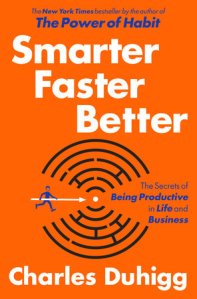
If you often yearn for 26-hour days — a bit more time to get done all that life requires and maybe, JUST MAYBE, a wink of sleep — this book is definitely for you!
Duhigg, Charles. Smarter, Faster, Better: The Secrets of Being Productive in Life and Business. New York: Random House, 2016. Print.
Genre: nonfiction (self-help-ish sans the tearful journal exercises)
Summary: Duhigg maps out the strategies successful people and industries use to attain utmost productivity. Defined here, productivity is ” the name we give our attempts to [best use] our energy, intellect, and time as we try to seize the most meaningful rewards with the least wasted effort.” In other words, Duhigg sets out to teach you how to succeed with less stress and struggle.
Critique: Author of the bestselling The Power of Habit (2012), Duhigg returns to deliver a fresh set of neurological schematics underscoring how to get the most optimal performances out of our brains. As always, he does a masterful job weaving technical exposition and compelling scenes involving the many people he profiled and interviewed while researching the book.
For example, you may be right in the middle of a based-on-true-events plane crash scene when Duhigg hits the pause button and delivers some bit of crucial data on the brain in times of extreme stress. The suspense mounts and just when you think you can’t take it, he hits play and resumes the gripping drama. The result: reading this book is lot like watching The Big Short.
Students studying how to compose creative nonfiction would do well to study Duhigg’s techniques.
Besides a good craft study, Duhigg’s latest book outlines some unconventional approaches to productivity all based on the latest behavioral and neuroscience research. Evidently, there IS a wrong way and a right way to make a to-do list. Most of us do it the wrong way, resulting in scads of wasted time, incomplete projects and missed deadlines–not to mention the scree of eroded self-confidence. Also, if you want to get through that nebulous inbox of unanswered emails, you’ll have to learn to reply like a U.S. Marine. Instead of setting the usual SMART goals (specific, measurable, achievable, realistic, timelined), set stretch goals. Finally, once you understand why fear is an intrinsic part of innovating new ideas, you can harness it to intensify your creativity and hit your deadlines and benchmarks. In other words, if you’re a writer, you’ll want this book on your shelf.
Comments